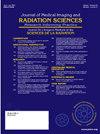上腹部不同专业间轮廓变化对MR-linac的几何和剂量学影响
IF 1.3
Q3 RADIOLOGY, NUCLEAR MEDICINE & MEDICAL IMAGING
Journal of Medical Imaging and Radiation Sciences
Pub Date : 2025-05-13
DOI:10.1016/j.jmir.2025.101980
引用次数: 0
摘要
背景与目的:量化放射治疗师(RTs)与放射肿瘤学家(ROs)在MR成像上腹部危险器官(OARs)轮廓时,划定可变性的几何准确性和剂量学影响。材料与方法8名RT和5名RO志愿者在3例原发性肝癌的MR图像上勾画出6个腹部桨形。然后重新计算临床计划,并使用研究轮廓线生成OARs的剂量-体积直方图。使用骰子相似系数(DSC)、一致距离(DTA)和阈值OAR体积剂量来量化RT与RO轮廓的差异。结果ro - STAPLE与RT - STAPLE比较,每个患者和每个器官的DSC均≥0.7。除十二指肠和小肠外,RO - STAPLE与RT - STAPLE的DTA表面中位差均为0.4 cm。在10/24 OAR容积中,8rt和5ro的平均剂量值相差小于5%。在7个桨叶容积中,RT等高线的平均温度比RO等高线高5%,在7个桨叶容积中,RT等高线的温度比RO等高线低5%。十二指肠、大肠和小肠的声腔体积较低。只有胃5cc的平均剂量超过了RO和RT轮廓的阈值剂量限制。RO - STAPLE和个体RT轮廓的剂量差异与DSC或DSC均无显著相关(ρ <;0.404)。在划定可变性的剂量学影响方面,患者之间存在很大差异。结论上腹部OAR的观察者间描述差异对于ROs和RTs来说都是很大的。这些体积差异对剂量学的影响由于桨叶靠近目标和平面剂量学的方向而得到缓和。本文章由计算机程序翻译,如有差异,请以英文原文为准。
Geometric and dosimetric impact of inter-professional contour variability in the upper abdomen for MR-linac
Background and purpose
To quantify the geometric accuracy and dosimetric impact of delineation variability for Radiation Therapists (RTs) compared to Radiation Oncologists (ROs) when contouring the organs at risk (OARs) within the upper abdomen on MR imaging.
Materials and methods
Eight RT and five RO volunteers contoured six abdominal OARs on MR images for three primary liver cancer cases. The clinical plan was then recalculated, and the study contours were used to generate dose-volume histograms for the OARs. Dice Similarity Coefficient (DSC), Distance to Agreement (DTA) and doses at threshold OAR volumes were used to quantify differences in RT vs. RO contours.
Results
RO STAPLE to RT STAPLE comparisons resulted in DSC ≥0.7 for each patient and each organ. The median DTA surface differences between the RO STAPLE and RT STAPLE were <0.4 cm for all OARs except duodenum and small bowel. The mean dose values for the 8 RT and 5 RO were less than 5 % different in 10/24 OAR volumes. RT contours resulted in mean differences >5 % hotter than RO contours in 7 OAR volumes, and >5 % colder in 7 OAR volumes. Colder OAR volumes were found for duodenum, large and small bowel. Only the stomach 5cc mean dose exceeded the threshold dose constraint for both RO and RT contours. Dose differences between RO STAPLE and individual RT contours were not significantly correlated with either DSC or DSC (ρ < 0.404). There were large inter-patient differences in the dosimetric impact of delineation variability.
Conclusions
Inter-observer delineation variability of OAR in the upper abdomen can be large for both ROs and RTs. The dosimetric impact of those volumetric differences is moderated by proximity of the OAR to the target and the orientation of the plan dosimetry.
求助全文
通过发布文献求助,成功后即可免费获取论文全文。
去求助
来源期刊

Journal of Medical Imaging and Radiation Sciences
RADIOLOGY, NUCLEAR MEDICINE & MEDICAL IMAGING-
CiteScore
2.30
自引率
11.10%
发文量
231
审稿时长
53 days
期刊介绍:
Journal of Medical Imaging and Radiation Sciences is the official peer-reviewed journal of the Canadian Association of Medical Radiation Technologists. This journal is published four times a year and is circulated to approximately 11,000 medical radiation technologists, libraries and radiology departments throughout Canada, the United States and overseas. The Journal publishes articles on recent research, new technology and techniques, professional practices, technologists viewpoints as well as relevant book reviews.
 求助内容:
求助内容: 应助结果提醒方式:
应助结果提醒方式:


